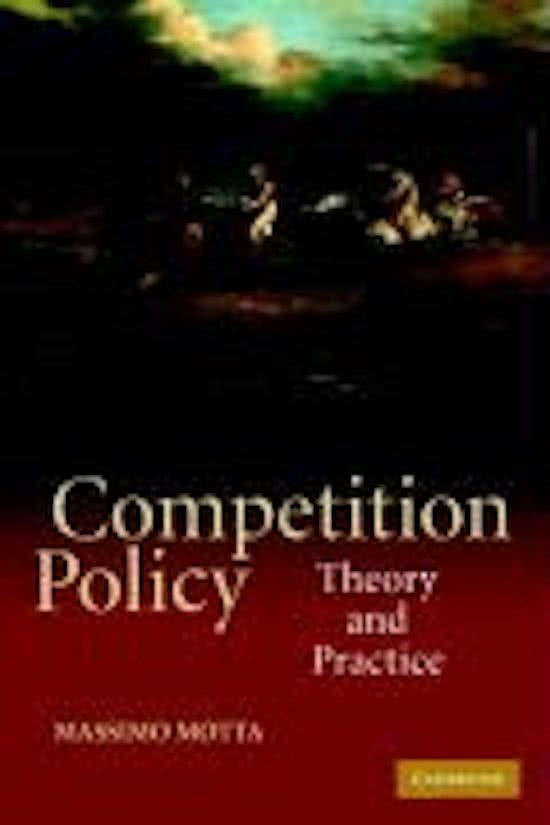COMPETITION POLICY
What is competition policy?
- The set of policies and laws which ensure that competition in the marketplace is not restricted in
a way that is detrimental to society
WELFARE AS THE OBJECTIVE OF COMPETITION POLICY
- Economic welfare measures the aggregate welfare (surplus) of different groups in the economy;
- Consumer surplus + producer surplus = total surplus (welfare);
- What happens when prices increase?
• Welfare lowest when market price = monopoly price, highest when P=MC.
• What happens when price rises?;
• Don’t take income distribution into account;
• Not only static analysis, also dynamic.
- It is important to notice that this concept of welfare completely overlooks the issue of income
distribution among consumers and producers
- Competing values’ should be considered (i.e. values that cannot be accounted for in the
economic model)
- Whose interest is more important:
• Consumers who gain because of lower prices;
• Producers who increase profits;
• Competitors who are forced out of the market
• EU – ‘aim of creating a single European market’.
- Competition policy should also consider distribution of income (Roberts)?
WHAT DOES ECONOMICS CONTRIBUTE?
- Important cases in SA?
- If you sit on a plane – what did the rest pay for their tickets? Is this against the law?
- Interplay between law and economics (rule of reason vs. per se prohibitions);
- Why are price fixing cartels so bad? Or monopolies?
- US early cases (Brown Shoe (1962)), FTC v Procter & Gamble (1967);
- Chicago School - 1970s, 1980s
- Industrial Organisation – sophisticated econometrics, economic modelling;
- EU – modernisation – effects based (also in SA).
- Competition Policy based on micro economics/ IO (including financial and behavioural
economics)
ROLE OF ECONOMIC THEORY
- Effective competition – what is important is the outcomes and not the forms;
- Economic models can aid the analysis;
1 of 51
,- Market power is the central economic concept;
- Two NB factors when looking at competition:
• Competitive price;
• Price elasticity;
- Effective competition when P=MC?;
- Effective price difficult to determine (compare real price with competitive price?);
- Economic analysis more complex
RATIONALE FOR COMPETITION POLICY: BRIEF HISTORY OF
COMPETITION POLICY - USA
- Motta’s view (p. 3): “If a government wanted to achieve objectives other than welfare, it should
resort to policy instruments that distort competition as little as possible”.
- Motta’s view is one that total welfare should be the aim of competition policy. He’s opposed by it
being captured by political interests. Essentially, he’s saying that if a government wants to
acheive anything other than welfare, the government should resort to any policy tool that doesn’t
distort competition.
- In many jurisdictions: “Competition policies have embraced many objectives other than
economic welfare”;
Anti-trust laws in the US
- US: ‘formation of trusts’. Was a response to price wars and market instability;
- In the second half of the 19th century, the US experienced a number of events which resulted in
the transformation of manufacturing industries. This enabled the formation of a large single
market, which in turn gave a powerful incentive to firms to exploit economies of scale and scope
- Trusts/ cartels (e.g. railroads and oil companies (Standard Oil Company), tobacco (American
Tobacco)) had the goal of creating a stable environment;
- Final consumers were hurt. Farmers and small businesses had enough political influence to
lobby for the creation of anti-trust laws in the US;
- Firms often tried to respond to price wars and market instability by way of price agreements
which enabled them to maintain high prices and margins
- Sherman Act (1890) – does not cover mergers;
- Clayton Act – mergers.
BRIEF HISTORY OF COMPETITION POLICY - EU
- EU- two different levels: national and supra-national (EU Commission);
- Germany a special case: cartels were seen as an instrument to control the instability created by
price competition;
- German law not only permitted price agreements, but also made them enforceable in courts.
Anti-cartel action was only taken in extreme cases
- Cartels were widespread. 1905: 385 cartels, 12 000 firms. 1923: 1 500 cartels;
- 1923: Cartel Law introduced, reaction to hyperinflation;
• But it was only in the 1950s that Germany became strict on this level
- 1930s (Great Depression), participation in cartels were compulsory for firms operating in
vulnerable sectors;
- SA – Agricultural Marketing Councils?
2 of 51
, • Since the 1998 Act, we now have a very active regime
- Treaty of Rome (1957) - establishing the EU, also articles on competition;
- Most important objectives of EU today: economic efficiency and European market integration
• Maintenance of competitive markets
OTHER OBJECTIVES OF COMPETITION POLICY
- What should the objectives be?
- Motta: better to pursue them with other policy instruments and not by using competition laws;
- Maximisation of consumer welfare – better than total welfare approach?
- Consumer standard?
• Consumer welfare not same as total welfare (what about firms?);
• Consumer standard will mean prices at or below MC, no profit incentive for firms;
• ‘Intervening to reduce profits might increase consumer surplus in the short-run, but it would
have a stronger negative effect on it in the long-run’;
• Economists usually prefer a total welfare approach
Other policy measures that could be pursued:
- Protection of consumers
- Protection of smaller firms
• ‘…little rationale behind a systematic use of competition policy towards helping SMEs’. Think
about allocative efficiency.
- Promotion of market integration
• Specific objective of the EU (Treaty of Rome);
• Political objective, not always consistent with economic welfare;
- Economic freedom (e.g. VRs?)
• Fighting inflation
- One reason to introduce control over cartels;
- Fairness and Equity
• Can sometimes be seen in the laws against the abuse of a dominant position
• Not always possible under competition policy
- Social reasons
• Competition rules have sometimes been relaxed to smooth social tensions
• E.g. Great depression in the USA – more lenient application, some price agreements could
help to avoid bankruptcy;
• “Crisis cartels” are sometimes tolerated in certain circumstances
- Political reasons
• E.g. Germany after WWII.
• Can be used to reduce inequality in income distribution.
- Environmental reasons
• Articles 6 and 174 of the Treaty of Rome.
• E.g. washing machines in the EU.
- Discontinuing production of imports of the least energy-efficient washing machines, which
represent some 10-11% of current EC sales
3 of 51
, • Should this be an objective of competition policy?
- Strategic reasons: Industrial and Trade policies
• National champions?
• Industrial and Trade Policy considerations have often been an obstacle to the enforcement of
competition policy
DEBATES ON: GOALS OF COMPETITION
- Many countries have included other goals in their policy, we need to compare this to SA
• But we need to bear in mind that our economic theory says perfect competition is ideal, but
that is not the case in the real world. Therefore, should government intervene?
- Competition laws a result of social and historical factors.
- Consider position in SA;
- Compare to international ‘best practice’;
• Commonly accepted that competition is good =efficiency, low prices and innovation. BUT
• Perfect competition still a text book ideal
• Reality= imperfect competition (monopoly, oligopoly, monopolistic competition)
• Unregulated markets - Pareto efficient?
• Optimal levels of government intervention
Dave Lewis: Competition Regulation: The SA Experience, ISCCO Conference 2000, Taipei.
- “Our act specifies a range of objectives to be served by competition law…objectives like
protection of SME’s, promotion of employment and support for the growth of Black-owned
enterprises. Some of these conflicting objectives are deeply embedded in the act.”
- Tribunal must evaluate a merger on competition grounds AND other criteria. “The Act provides
the Tribunal with no guidelines for weighting these criteria”.
- “The Act has been criticized for this with anti-trust scholars and academics particular vocal in
their criticism. However, my own view is that this is inevitable particularly in a developing country
where distributional and poverty problems loom large and where all social and economic policy,
no less competition policy, is expected to contribute to the alleviation of these first order
problems”
SA ‘PUBLIC INTEREST’ GOALS OF COMPETITION POLICY
The purpose of this Act is to promote and maintain competition in the Republic in order –
a) to promote the efficiency, adaptability and development of the economy;
b) to provide consumers with competitive prices and product choices;
c) to promote employment and advance the social and economic welfare of South Africans;
d) to expand opportunities for South African participation in world markets and recognise the role
of foreign competition in the Republic;
e) to ensure that small and medium-sized enterprises have an equitable opportunity to participate
in the economy; and
f) to promote a greater spread of ownership, in particular to increase the ownership stakes of
historically disadvantaged persons
NB: you need to know these goals for a test or exam in order to list them. Could be asked to
discuss the rationale of the inclusion of public interest goals
a) and b) are seen in most other competition policies, but the last 6 are South African specific
4 of 51







